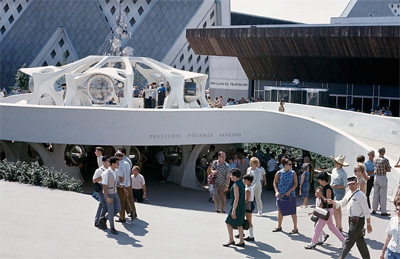The Polymer Pavilion
 The groovy Polymer pavilion was located on Île Sainte-Hélène, near the Metro station. The pavilion was sponsored by the Polymer Corporation of Canada, a company that, in 1967, supplied more than 90 nations with synthetic rubber, latex and plastic.
The groovy Polymer pavilion was located on Île Sainte-Hélène, near the Metro station. The pavilion was sponsored by the Polymer Corporation of Canada, a company that, in 1967, supplied more than 90 nations with synthetic rubber, latex and plastic.The pavilion's architecture had a fluid, molded-plastic quality. Crowning the pavilion was an intriguing metal sculpture named Curiosity, which summed up the theme of Polymer's presentation. Cylinders 3 feet wide provided entrances at the east and west sides of the pavilion.
 The pavilion had 2 levels. The upper level explored the fascination of electrostatics, the phenomena of wave motion and the nature of light and color. Visitors learned about the factors that made things take their particular shape.
The pavilion had 2 levels. The upper level explored the fascination of electrostatics, the phenomena of wave motion and the nature of light and color. Visitors learned about the factors that made things take their particular shape.Along the ramps that lead from one level to another, displays illustrated the countless marvels that could be obtained by the polymerization, or mixing, of natural elements.
The lower level discussed the sub-microscopic world of molecules. Huge, blown up models of molecules could be observed. A comic exhibit of organic trickery, such as rubber made to look like cheese, demonstrated the polyvalence of polymer compounds.
 images: (1) alamedainfo.com
images: (1) alamedainfo.com(2) flickr.com
(3) personal collection
Labels: fantastic plastic, pavilions-a-gogo

5 Comments:
Was the pavilion made of polymer?
Good question. Unfortunately, the documents I have consulted do not mention the building materials of the pavilion.
I would think, though, it's safe to assume that it was made of some sort of plastic derivative...
trippy...
It was made of concrete as i remember.
Just found a news release about the polymer Pavilion. It said; Polymer's pavilion is an open walk-throught type structure.It is constructed of a special gas concrete,a material new to Canada and necessitated by the pavilion intricate hand-sculptured design.
Post a Comment